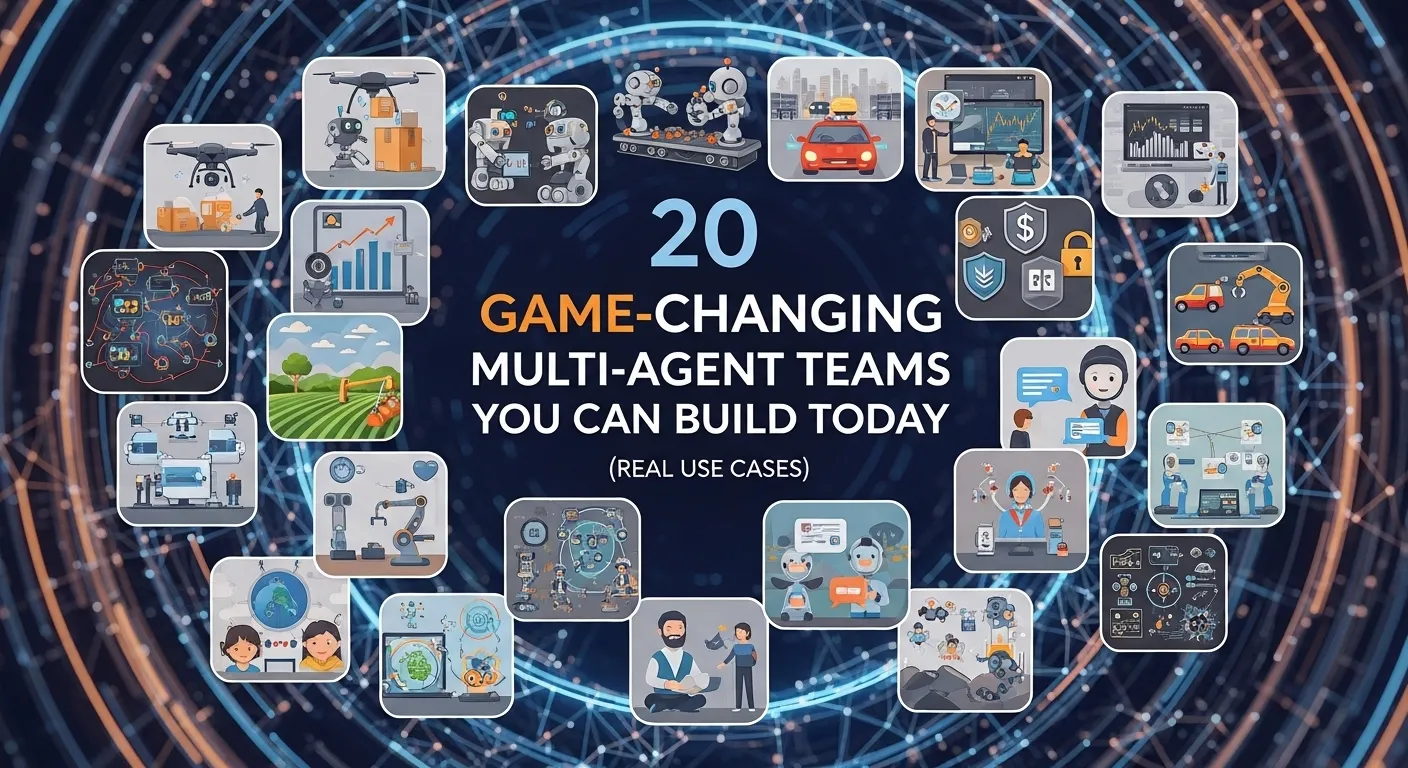Forget solo AI assistants—the real magic happens when multiple AI agents team up to tackle complex tasks. Here are 20 ready-to-deploy multi-agent teams that are revolutionizing workflows right now.
What Are Multi-Agent Teams?
Think of multi-agent teams as your AI dream team—specialized AI assistants that collaborate like a well-oiled machine. Instead of one AI trying to do everything, you have researchers, writers, analysts, and validators working together to deliver superior results.
Essential Tech Stack
Most teams use frameworks like CrewAI, AutoGen, or LangGraph to coordinate multiple AI models. These tools handle the complex choreography of task delegation, communication, and result aggregation.
20 Ready-to-Ship Use Cases
Content & Marketing
- Content Creation Squad: Researcher → Writer → Editor → SEO Optimizer workflow
- Social Media Team: Trend Analyst → Content Creator → Scheduler → Engagement Monitor
- Market Research Pod: Data Collector → Analyst → Report Writer → Presentation Builder
- Email Campaign Crew: List Manager → Copywriter → Designer → Analytics Tracker
- SEO Task Force: Keyword Researcher → Content Optimizer → Link Builder → Performance Analyst
Development & Operations
- Code Review Team: Syntax Checker → Security Auditor → Performance Optimizer → Documentation Writer
- Bug Hunting Squad: Tester → Debugger → Fix Implementer → QA Validator
- DevOps Automation: Infrastructure Planner → Deployment Manager → Monitor → Alert Responder
- API Integration Team: Endpoint Analyzer → Connection Builder → Tester → Documentation Creator
- Database Optimization Crew: Performance Auditor → Query Optimizer → Index Manager → Report Generator
Business & Analytics
- Financial Analysis Team: Data Collector → Trend Spotter → Risk Assessor → Report Generator
- Customer Support Pod: Query Classifier → Solution Finder → Response Writer → Satisfaction Monitor
- Sales Intelligence Crew: Lead Qualifier → Outreach Planner → Follow-up Manager → Deal Tracker
- Competitive Analysis Team: Market Researcher → SWOT Analyst → Strategy Recommender → Presentation Builder
- Legal Document Review: Clause Analyzer → Risk Identifier → Compliance Checker → Summary Generator
Creative & Research
- Academic Research Team: Literature Reviewer → Hypothesis Generator → Data Analyst → Paper Writer
- Product Design Crew: User Researcher → Concept Generator → Prototype Designer → Feedback Analyzer
- Video Production Team: Script Writer → Storyboard Artist → Voiceover Generator → Editor
- Game Development Pod: Game Designer → Level Creator → Character Developer → Tester
- Learning & Development: Curriculum Planner → Content Creator → Assessment Designer → Progress Tracker
Implementation Guide
- Define Your Goal: Start with a clear objective—what problem are you solving?
- Map Agent Roles: Break down the task into specialized roles with clear responsibilities
- Choose Your Framework: Select CrewAI for business workflows, AutoGen for complex reasoning, or LangGraph for custom orchestration
- Build Communication Protocols: Define how agents share information and hand off tasks
- Test & Iterate: Start small, monitor performance, and refine your team structure
Cost Considerations
Multi-agent teams typically cost 3-5x more than single-agent workflows due to multiple API calls. However, the quality and speed improvements often justify the expense. Budget $20-100 per complex workflow depending on task complexity and model choices.
Common Challenges
- Cost Management: Multiple agents mean multiple API calls—monitor usage closely
- Communication Overhead: Too many agents can lead to inefficient coordination
- Error Propagation: Mistakes can cascade through the team—build in validation checkpoints
- Complex Debugging: Tracing issues across multiple agents requires robust logging
FAQs
How many agents should I use?
Start with 2-4 agents for most workflows. Add more only if you need specialized expertise that can’t be handled by existing team members.
What’s the learning curve?
Basic teams can be built in days using frameworks like CrewAI. Complex orchestration might take weeks to master.
Are multi-agent teams reliable?
Yes, with proper error handling and validation layers. Most failures occur from poor task definition rather than agent limitations.
Can I mix different AI models?
Absolutely! Many teams combine GPT-4 for reasoning, Claude for writing, and specialized models for specific tasks.
Bottom Line
Multi-agent teams represent the next evolution in AI productivity—transforming complex workflows from solo struggles into collaborative masterpieces. The hardest part isn’t the technology—it’s imagining the possibilities. Which team will you build first?

